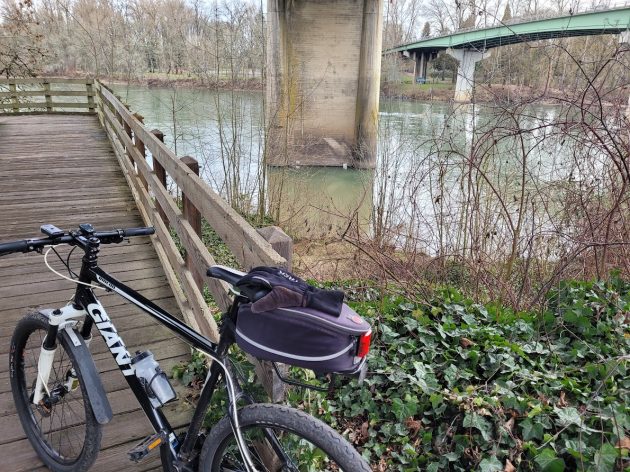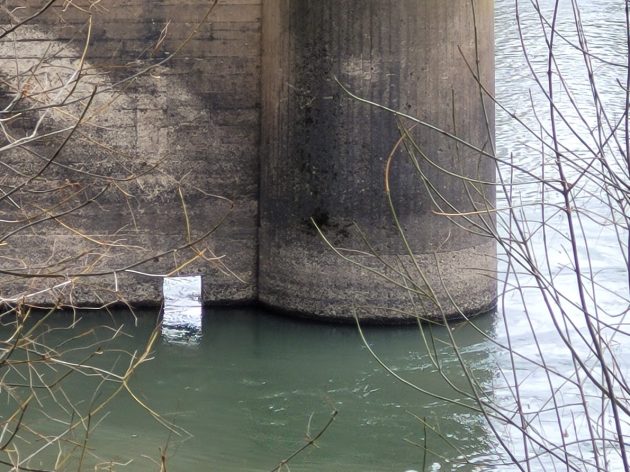
From the riverside boardwalk, you can just barely see the curious holes in the concrete pier holding up this end of the Ellsworth Street Bridge.
Last November I ran a story here speculating about a structural detail of Albany’s Ellsworth Street Bridge, a detail that seemed puzzling at the time and still does.
What I had noticed, on the Benton County side of the bridge, were two rectangular holes near the waterline in the pier closest to the bank.
When I asked about it, ODOT explained that the holes were left when workers removed the forms used to pour the piers when the bridge was built in 1925.
I had not noticed the holes before. They’re only visible when the river runs fairly low, as it did that month.
On Monday the Willamette was running a little less than 5 feet on the Albany gauge. And guess what: The pier on the Linn County side has the same kind of holes. I happened to see them when I looked that way from the Dave Clark Path.
Is this worth mentioning? Not really. Except that last November I had wondered whether holes on the north pier were the only ones on that bridge.
No, they’re not, as you can see in the photos. ODOT’s regional spokeswoman had leaned from others in the agency last fall, and then told me, that these kinds of holes are common in bridges constructed at the time.
That still leaves me wondering why there aren’t similar gaps higher up. Surely the forms on both sides of the concrete wall had to be held together by something higher up as well. And why didn’t removing those ties or cross pieces leave similar holes?
This may not rank among the great mysteries of the 20th Century. It’s just a nagging little question, and I’d like to know. (hh)

The downstream hole in the south pier of the Ellsworth Street Bridge.


It seems to me that the people you asked about the holes in the bridge concrete don’t know the answer. They are just “faking it until they make it ” as the saying goes. So, they gave you a line of B.S., as another saying goes! “Ain’t” capitalism and the resulting failed government great!!
I’m not a engineer. But I’m a mom. So I’m guessing the gap is there for water flowing reasons. From my extensive experience building bridges and dams out of mud and motes around castles, a hole in a structure to allow water to flow through, is better than a solid wall for the water to push over. Or, maybe it’s a access for some mechanical repairs. Or maybe there were little arms or levers to control water flow in there.
Let us know what you discover!!
Thanks, Brenda. Being a Mom is being an engineer and being a little of almost every occupation there is!!! Thanks for bringing some common sense to our yakkety-yak.
I also hope the guy who answered Hasso’s questions sees your comment.
You should let the city council know about it. They can have fifteen meetings about it, then say it due to the homeless people living there along the river. Then have fifteen more meetings deciding how to fund the shelter to solve the holes in the bridge problem. Or get money to just cut some more trees down along the river to discourage the homeless from living there. Or both! Kill two birds with one stone! Probably the real reason is they were there for the portable toilets used by the workers. LOL They better bill ODOT for their past usage permits.
Absolutely love what you wrote (readers…it is the article above this one). Write more of your witty and true, missives.
Seriously, when you look closely it looks like a masonry structure, concrete slabs. They may have been used to stabilize the base during construction as they built it up. Maybe metal strapping or cables were fed through the holes to shore up the bases too? I understand your curiosity. I would have noticed that as well.
Old billy goat walkway.
Terrible pictures. I can only guess where the holes are because there are so many little, black spots all over.
The black spots are moss on the old bridge supports or dead leaves on branches! I don’t see any other black spots.
Several of those black spots are holes that line up.
There’s one near the left corner of the opening in the last picture. There are two above it that look equally spaced.
There’s a horizontal line of equally-spaced spots in what I’ll call the 7th course above the feature.